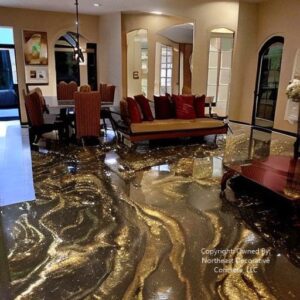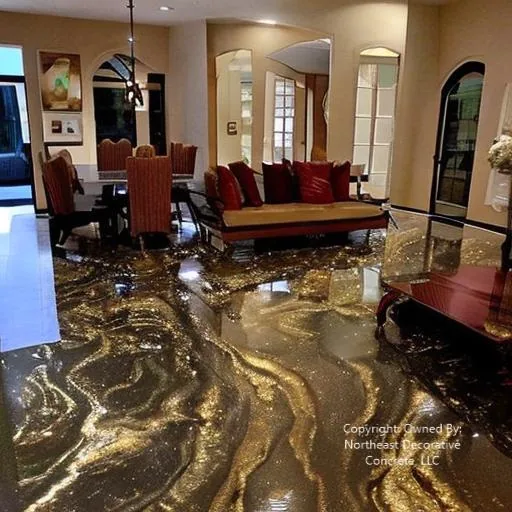
Achieving 100% Concrete Moisture Testing Before Sealing
Picture this: You’ve added a stunning stamped concrete patio to your yard in New Hampshire. The detailed patterns look like natural stone, and the colors match the fall leaves well. But the surface starts peeling six months later, and mysterious bubbles appear. What went wrong? The culprit? Skipping proper moisture testing before sealing.
In New Hampshire, humid summers and cold winters can trap moisture in concrete floors, causing severe vapor transmission damage. This guide explains how, why, and when to test concrete humidity, which helps keep stamped concrete looking great for years.
Key Takeaways
-
Test, Don’t Guess: RH testing is non-negotiable for stamped concrete.
-
Climates are Tricky: Humidity and frost demand rigorous prep.
-
Seal Only When Dry: Follow ASTM standards—not the calendar.

What Is Concrete Floor Moisture Testing?
Concrete isn’t just a rock-hard material—it’s porous, like a sponge. Water from rain, snow, or groundwater can seep into it; if sealed too soon, that moisture gets trapped under the floor covering. Over time, it escapes, causing sealant failure, substrate cracks, or air entrapment mold. Moisture surface preparation testing measures how much water lurks inside your floor before sealing it.
Why Different Climates Demand Extra Caution
-
Freeze-thaw cycles: Water expands when frozen, creating cracks.
-
High humidity: Summer moisture slows concrete drying.
-
Rainfall: NH averages 47 inches of rain yearly—more than the U.S. average.
You’re gambling with your concrete’s lifespan without measuring moisture in the slab levels.
How to Test Moisture in Stamped Concrete
Not all moisture tests are equal. Here’s a breakdown of the top methods used:
| Method | How It Works | Best For | Accuracy |
|---|---|---|---|
| Calcium Chloride (ASTM F1869) | Measures vapor emission with salt crystals. Place on concrete for 72 hours. | Quick checks, small projects | Moderate |
| Relative Humidity (ASTM F2170) | Drills holes and inserts sensors to measure internal humidity. | Large slabs, high-risk areas | High |
| Plastic Sheet Test | Tape plastic to concrete; check for condensation after 24 hours. | DIYers, initial screening | Low |
Always use Relative Humidity (RH) flooring installers testing for stamped concrete. It’s the gold standard and detects moisture deep in the floor.
Why 100% Testing Matters
In 2023, a family in Milford skipped RH testing and finished their new stamped concrete driveway without it. By winter, the sealant peeled and cracked spiderwebs across the surface. Repairs cost $8,500—double the original sealing price!
Lesson Learned:
“Moisture doesn’t care about floor covering shortcuts. Test every square foot, or pay the price later.”
Step-by-Step: How to Test Moisture Like a Pro
1. Prep the Moisture Vapor Surface
-
Clean debris with a broom or a vacuum.
-
Ensure the concrete is at least 28 days old (new pours curing in the cold hold more moisture).
2. Choose Your Moisture Content Method
-
For DIY: Start with the plastic sheet test. No condensation? Move to calcium chloride.
-
For pros: Use RH sensors at 40% of the floor’s depth (e.g., 1.2″ deep for a 3″ slab).
3. Record Test Method Conditions
-
Track temperature and humidity (Summer humidity often exceeds 70%).
-
Wait 48 hours after HVAC installation for accurate RH concrete coating readings.
4. Analyze Acceptable Moisture Results
-
Safe levels:
-
RH ≤ 75%
-
Calcium chloride ≤ 3 lbs/1,000 sq. ft./24 hrs
-

Common Moisture Level Mistakes to Avoid
-
Ignoring Weather Forecasts: Testing during rain? Humidity spikes skew results.
-
Skipping Multiple Tests: One dry spot doesn’t mean the whole slab is safe.
-
Using Only Surface Meters: They miss moisture trapped more profoundly in the concrete slab flooring system.
A patio at a Stratham café failed because it tested only sunny areas. Hidden moisture under shaded sections ruined the epoxy coating.
Pro Tips for Flawless Sealing
-
Wait for Dry Spells: Test after three or more sunny days.
-
Use a Dehumidifier: Speed up drying in enclosed spaces (e.g., basements).
-
Consult a Local Expert: NH’s soil types (e.g., clay in Concord) hold more moisture.
Conclusion
Stamped concrete slabs add elegance to NH homes, but moisture is their silent enemy. Test carefully, use the proper methods to avoid expensive redos, and keep your surfaces looking great. Remember: Testing is your best weapon in the battle between concrete and moisture.
Next time you walk on a perfectly sealed patio, remember the science and effort that made it flawless.
Frequently Asked Questions:
Q: Why is ASTM F2170 RH testing critical for freeze-thaw climate?
Answer:
ASTM F2170 says to drill probes to 40% of the floor installation depth. For elevated slabs, drill to 20%. This lets you measure internal relative humidity (RH), vital in NH. Freeze-thaw cycles trap moisture, which expands. This expansion leads to sealant failure. RH tests find moisture below the surface that calcium chloride tests (ASTM F1869) overlook.
“Test slabs within the concrete 48 hours after rain—coastal salt air slows drying by 15 to 20%.”
Q: Can I rely on surface moisture meters for stamped concrete?
Answer:
No. Surface meters, like impedance meters per ASTM F2659, only check the top ½” of concrete. They miss moisture that lies more deeply in the concrete surface. NH’s high humidity (avg. in summer, 70% humidity) creates moisture gradients. This makes in-situ RH probes the only reliable test method at 100%.
Data Check:
| Method | Depth Tested | Accuracy in NH |
|---|---|---|
| Surface Meter | 0.5” | Low (30-50%) |
| RH Probe (F2170) | 1.2”-3” | High (95%) |
Q: How does the water table affect moisture mitigation before sealing?
Answer:
Like Portsmouth, NH’s coastal moisture conditions areas have high water vapor tables. This pushes moisture up through the floors. If RH exceeds 75%, installers must use:
-
Desiccant dehumidifiers (avg. 8 days for 1,200 sq. ft.)
-
Vapor-retarding membranes (≥10-mil poly) underfloor installation.
Case Study: A café in Portsmouth used industrial dehumidifiers. They cut RH from 82% to 72%, which saved them $12K in repairs.
Q: Why does HVAC affect RH test results in buildings?
Answer:
HVAC systems alter slab drying rates. Per ASTM F2170, stabilize indoor conditions (65–85°F, 40–60% RH) for 48+ hours pre-test. Unregulated HVAC can inflate RH readings in NH’s humid summers by 15%.
Procedural Must:
-
Seal testing holes with silicone to prevent ambient air interference.
Q: What’s the slabs’ maximum MVER (moisture vapor emission rate)?
Answer:
Per ASTM F1869, ≤3 lbs/1,000 sq. ft./24 hrs via calcium chloride tests. NH contractors focus on keeping RH at or below 75% (ASTM F2170) for epoxy-durable concrete coating sealants. This is important because MVER does not consider subfloor excess moisture within the slab from frost moisture vapor transmission heaving.
Mitigation for High MVER:
-
After grinding, 100% solid epoxy coating system sealants (e.g., AC-Tech 2170) are applied to open the pores.
Key Technical Takeaway:
“RH testing isn’t optional in NH—it’s chemical resistance insurance against $8K+ concrete slab resealing costs.”
Our Locations:
Nashua, NH
North Hampton, NH
Concord, NH

